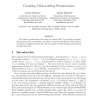120
click to vote
COMBINATORICS
2002
15 years 4 days ago
2002
: We generalize the notion of pattern avoidance to arbitrary functions on ordered sets, and consider specifically three scenarios for permutations: linear, cyclic and hybrid, the f...
COMBINATORICS
2002
15 years 4 days ago
2002
We consider the two permutation statistics which count the distinct pairs obtained from the final two terms of occurrences of patterns 1
84
Voted
COMBINATORICS
2002
15 years 4 days ago
2002
We consider permutations that avoid the pattern 1324. By studying the generating tree for such permutations, we obtain a recurrence formula for their number. A computer program pr...
COMBINATORICS
2002
15 years 4 days ago
2002
Let In() denote the number of involutions in the symmetric group Sn which avoid the permutation . We say that two permutations , Sj may be exchanged if for every n, k, and order...
83
Voted
COMBINATORICS
2002
15 years 4 days ago
2002
Several authors have examined connections between permutations which avoid 132, continued fractions, and Chebyshev polynomials of the second kind. In this paper we prove analogues...
COMBINATORICS
2000
15 years 4 days ago
2000
We constructively prove that the partially ordered set of finite permutations ordered by deletion of entries contains an infinite antichain. In other words, there exists an infini...
COMBINATORICS
2000
15 years 4 days ago
2000
A (multi)hypergraph H with vertices in N contains a permutation p = a1a2 . . . ak of 1, 2, . . . , k if one can reduce H by omitting vertices from the edges so that the resulting ...
82
Voted
CORR
2004
Springer
15 years 5 days ago
2004
Springer
Sorting by reversals is an important problem in inferring the evolutionary relationship between two genomes. The problem of sorting unsigned permutation has been proven to be NP-ha...
100
Voted
COMBINATORICS
2004
15 years 5 days ago
2004
We study the distribution of the statistics `number of fixed points' and `number of excedances' in permutations avoiding subsets of patterns of length 3. We solve all th...
118
Voted
TIFS
2008
15 years 7 days ago
2008
Ordered channels, such as those provided by Internet protocol and transmission control protocol protocols, rely on sequence numbers to recover from packet reordering due to network...



